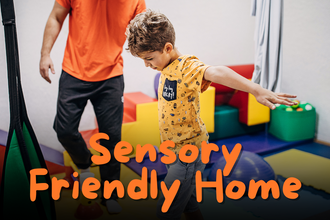
Creating a sensory-friendly home environment is necessary for children with sensory processing issues. Whether your child has autism, ADHD, or sensory processing disorder (SPD), a sensory-friendly home can provide a safe and comfortable space that meets their unique needs.
By making thoughtful adjustments to your living space, you can help your child feel more secure and supported in their daily activities. Understanding your child's sensory needs and preferences is the first step in this journey. Let's see how you can make your home a place where your child can thrive.
Understanding Sensory Processing
What is Sensory Processing?
Sensory processing refers to how the nervous system receives messages from the senses and turns them into appropriate motor and behavioral responses. Children with sensory processing issues may be over-responsive or under-responsive to sensory stimuli, which can impact their daily activities and interactions.
Types of Sensory Responses
A child who is over-responsive to sensory input might find everyday sounds overwhelming or textures of certain clothes unbearable. On the other hand, a child who is under-responsive might seek out additional sensory input, such as touching everything or making loud noises.
Observing Your Child
Understanding your child's sensory profile involves observing their reactions to various stimuli and identifying what triggers discomfort or anxiety. This awareness is the first step in creating a sensory-friendly home environment that is according to their specific needs and helps them feel more comfortable and in control.

Choosing the Right Colors
Impact of Colors on Sensory Experience
Colors can have a significant impact on a child's sensory experience. Calming colors such as soft blues, greens, and pastels can create a soothing environment, while bright and bold colors may be overstimulating.
Selecting Calming Colors
When decorating your child's room, opt for muted tones and avoid overly vibrant colors. Soft blues and greens are often associated with tranquility and can help reduce anxiety. These colors can be used on walls, bedding, and furniture to create a cohesive and calming environment.
Using Natural Elements
Consider incorporating natural elements and textures to enhance the calming effect. Wooden furniture, soft fabrics, and nature-inspired decor can create a harmonious and relaxing atmosphere. You can also use accent colors strategically to add interest without overwhelming the senses.
Choosing the Right Finish
Additionally, consider the finish of the paint. Matte finishes are less reflective and can be less visually stimulating than glossy finishes. This small detail can make a big difference in creating a sensory-friendly environment. By thoughtfully selecting colors and finishes, you can create a space that feels safe and inviting for your child.

Optimizing Lighting
Importance of Natural Light
Lighting plays a key role in creating a sensory-friendly environment. Natural light is ideal, so try to maximize the amount of daylight in your home. However, harsh lighting can be overwhelming for some children.
Soft, Adjustable Lighting
Consider using soft, adjustable lighting options such as dimmable LED lights, lamps with warm bulbs, and blackout curtains to control the light intensity. Avoid using fluorescent lights, which can flicker and cause sensory discomfort.
Maximizing Natural Light
To maximize natural light, keep windows unobstructed and use light, airy curtains. Mirrors can also help reflect natural light and brighten up a room. However, be mindful of glare, which can be distressing for some children.
Creating a Calming Sleep Environment
Consider using blackout curtains or blinds in your child's bedroom to block out external light and create a dark, calming environment for sleep. A consistent sleep environment can help improve sleep quality, which is essential for overall well-being.

Creating a Sensory Space
Designating a Sensory Space
Designating a specific area in your home as a sensory space can provide your child with a safe haven to retreat to when they feel overwhelmed. This space can be filled with sensory-friendly items such as soft cushions, weighted blankets, and tactile toys.
Choosing Sensory-Friendly Items
A sensory space should be designed with your child's preferences and needs in mind. Use soft, comfortable seating options like bean bags, floor cushions, or a cozy armchair. Weighted blankets can provide deep pressure input, which is calming for many children with sensory processing issues.
Incorporating Tactile Toys
Include a variety of tactile toys and activities to engage your child's sense of touch. Items such as textured balls, sensory bins filled with rice or sand, and fidget toys can provide tactile stimulation.
Creating a Calming Atmosphere
Visual elements can also play a role in creating a calming sensory space. Soft lighting, calming colors, and minimalistic decor can help reduce visual overstimulation. If your child finds visual input soothing, consider adding a bubble tube, lava lamp, or a light projector that displays gentle, moving patterns on the walls or ceiling.
Encouraging Use of the Sensory Space
Make sure the sensory space is easily accessible and that your child understands it's a place they can go to whenever they need to calm down or take a break. Encourage your child to use this space regularly to help them self-regulate and manage their sensory needs.

Incorporating Sensory Activities
Sensory Bins
Incorporating sensory activities into your daily routine can help your child manage sensory overload and improve their sensory processing skills. Sensory bins are a versatile and engaging way to provide tactile stimulation. Fill bins with materials such as rice, beans, water beads, or sand, and include small toys or tools for your child to explore.
Fidget Toys
Fidget toys can help children with sensory processing issues focus and manage their sensory input. Items like stress balls, spinner rings, and textured putty can provide tactile stimulation and help reduce anxiety. Keep a variety of fidget toys available in different areas of the house so your child can use them as needed.
Deep-Pressure Activities
Deep-pressure activities can have a calming effect on children with sensory processing issues. Activities such as rolling a yoga ball over the body, using a weighted vest, or engaging in tight hugs can provide the proprioceptive input that many children find soothing.
Engaging Other Senses
In addition to tactile and proprioceptive activities, consider incorporating activities that engage other senses. For example, listening to calming music, engaging in movement activities like swinging or jumping, and using visual tools like light projectors can help your child regulate their sensory input.
Activities According to Your Child Preferences
Be mindful of your child's sensory preferences and sensitivities when planning activities. Some children may need more or less sensory input, so it's important to select activities according to their individual needs.

Organizing Clutter
Reducing Sensory Overload
A clutter-free environment can significantly reduce sensory overload. Organize toys, clothes, and other items in labeled bins and keep them out of sight when not in use. Use storage solutions like shelves, drawers, and baskets to keep your home tidy and organized.
Decluttering Your Home
Start by decluttering your home and removing items that are no longer needed or used. This can help reduce visual and tactile distractions and create a more streamlined environment. Consider donating or storing items that are not essential to free up space.
Using Storage Solutions
Once you've decluttered, use storage solutions to keep remaining items organized and out of sight. Labeled bins and baskets can help your child know where items belong and make it easier to clean up. Shelving units and drawers can keep items neatly stored and accessible.
Creating Designated Areas
Create designated areas for different activities to help your child understand where things belong. For example, have a specific area for toys, a space for arts and crafts, and a place for school supplies. This can help create structure and make it easier for your child to find and put away items.
Minimizing Visual Clutter
Keep surfaces clear and minimize the number of items on display. This can help reduce visual clutter and create a more calming environment. Use closed storage solutions whenever possible to keep items out of sight and create a more organized and serene space.

Soundproofing and Reducing Noise
Identifying Noise Triggers
Noise can be a major trigger for children with sensory sensitivities. To create a quieter environment, consider soundproofing your home by adding carpets, rugs, and curtains to absorb sound.
Using White Noise Machines
White noise machines or fans can be used to create a consistent background noise that helps mask sudden or disruptive sounds. This can be especially helpful during sleep or quiet activities.
Encouraging Use of Noise-Canceling Headphones
Noise-canceling headphones can be a valuable tool for children with sensory sensitivities. Encourage your child to use them during noisy activities or when they need to concentrate. These headphones can help block out background noise and create a more controlled auditory environment.
Soundproofing Solutions
Consider using door sweeps, weather stripping, and acoustic panels to further reduce noise. These soundproofing solutions can help minimize noise from outside and create a quieter, more peaceful home environment.
Creating a Quieter Environment
Reducing noise and creating a quieter environment can help your child feel more comfortable and less overwhelmed by sensory input. By making these adjustments, you can create a more supportive and accommodating home for your child.

Creating Routine and Structure
Establishing a Daily Schedule
A predictable routine can provide a sense of security and stability for children with sensory processing issues. Create a daily schedule that includes time for sensory activities, relaxation, and structured play.
Using Visual Schedules
Visual schedules can be particularly helpful for children with sensory processing issues. Use pictures, icons, or charts to represent different activities and routines. This can help your child understand what to expect and make transitions smoother.
Incorporating Sensory Activities
Incorporate sensory activities into your daily schedule to help your child regulate their sensory input. For example, include time for sensory breaks, deep-pressure activities, or sensory play throughout the day.
Using Timers and Reminders
Timers and reminders can also be useful tools for maintaining routine and structure. Set timers for specific activities or transitions to help your child stay on track and manage their time. Use verbal or visual reminders to cue your child about upcoming activities or changes in routine.
Being Flexible
Be flexible and adjust the routine as needed to accommodate your child's sensory needs. While consistency is important, it's also essential to be responsive to your child's sensory cues and make adjustments when necessary.

Encouraging Outdoor Play
Benefits of Outdoor Play
Spending time outdoors can be incredibly beneficial for children with sensory processing issues. Outdoor activities such as swinging, climbing, and playing in the sand can provide valuable sensory input and help regulate sensory experiences.
Creating a Sensory-Friendly Outdoor Space
Create a safe and sensory-friendly outdoor space in your backyard with sensory-friendly equipment like swings, trampolines, and sensory paths. These activities can provide a variety of sensory experiences that are beneficial for children with sensory processing issues.
Scheduling Outdoor Playtime
Encourage your child to engage in outdoor play regularly. Schedule outdoor playtime as part of your daily routine and make it a priority. Outdoor activities can provide a change of scenery and a break from indoor sensory stimuli, which can be refreshing and rejuvenating.
Involving Your Child
Be mindful of your child's sensory preferences and sensitivities when planning outdoor activities. Some children may need more or less sensory input, so it's important to select activities according to their individual needs. Provide options and allow your child to choose activities that they enjoy and find comforting.
Incorporating Outdoor Play
Incorporating outdoor play into your daily routine can help your child develop better sensory processing skills and create a more balanced sensory environment. By providing opportunities for sensory input and active play, you can support your child's sensory needs and promote overall well-being.

Final Verdict
Creating a sensory-friendly home means understanding your child's sensory needs and making thoughtful changes. Choose calming colors, adjust lighting, create sensory spaces, organize clutter, and reduce noise to support your child. Customize these tips to fit your child's needs for a comforting home. Even small adjustments can make a big difference in how comfortable and happy your child feels.
Become a part of Prideful on the Spectrum's community today where we spread awareness about the diverse spectrum of abilities in autistic individuals. Explore our carefully crafted toys and a clothing line that aims to celebrate differences and challenge stereotypes. Come and join hands in bringing a change- Explore now!







